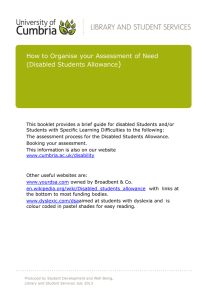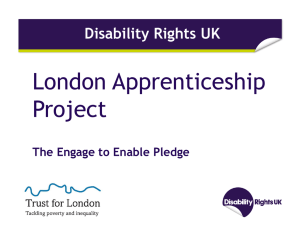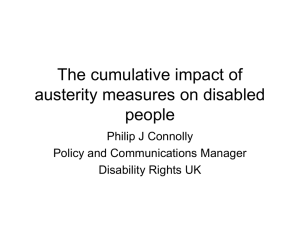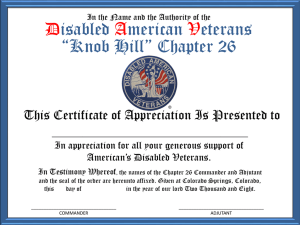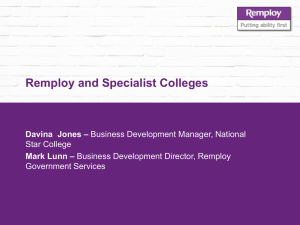Liz`s presentation
advertisement
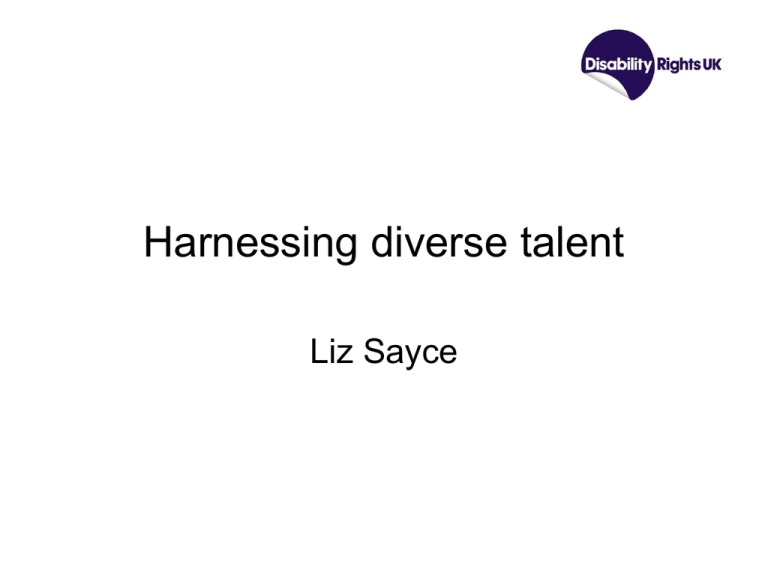
Harnessing diverse talent Liz Sayce About me Disability Rights UK: Disabled people leading change • Board composed of leaders with lived experience of mental and physical health conditions/disability: Disabled People’s Organisation (DPO) leaders, experts in communications, finance, business… • Formed Jan 2012, 3-way merger Constituencies and beneficiaries: • >300 organisational members • 674,000 website visitors in year 1 • 1 million factsheets downloaded, 93% said information met their purposes UK Commission for Employment and Skills: • Employer ownership of skills • Scaling the youth employment challenge Review of disability employment programmes 2011: • Led to Access to Work changes eg no cost sharing small business, greater marketing, more take-up mental health support, some coverage work experience, reduced red tape. Numbers beginning to rise • Remploy. Residential training colleges Government preparing a disability employment strategy Increasing diversity • Superdiversity: Britain is becoming more diverse eg more children live in families of mixed or multiple racial and/or religious heritage • UK Fulfilling Potential evidence says 19% population covered by Equality Act definition of disability • Many go in and out of the experience of disability (only 2% are born with their impairment) ‘Their land is our land’ (Andrew McDonald) • Fluid identities: only 24% consider ourselves ‘disabled’ (lowest in young people) Individuals and families are (increasingly) multiply affected: • Individuals with 3 or more impairments will rise by a third by 2018 • Almost half of disabled children live with a disabled parent • 15% of disabled people are ‘carers’ compared to 8% of non-disabled people Who can improve skills and careers in tough times? Employee and learner power – taking charge of your learning and career. Mobilising peer support Employer ambition – securing competitive advantage through developing skills, in line with an industrial sectorbased strategy. Strong partnerships between employers and colleges, trade unions. Employer ownership pilots - £67 million public investment, matched by £98 million employer investment. Radical ideas tested eg Siemens and BAE systems training employees through their supply chains Public money invested to support both. Developments with clear line of sight to industrial strategy, economic growth Employee and learner power Challenge 1: young people Young disabled people at risk of becoming a ‘lost generation’, living with long-term poverty and exclusion: • At 16, the aspirations of disabled and non-disabled people are broadly the same. By 26 their expectations have diverged: disabled 26 year olds are much more likely to say ‘nothing I do makes any difference’. • At 26, disabled people are nearly 4 times as likely to be out of work; and even in work to earn less. • But the gap between disabled and non-disabled 19 year olds getting level 2 qualifications (A level equivalent) has gone down by 1% a year in the last decade. Some things are getting better • Main reason employers reject applications is lack of experience – yet only 27% offer work experience, 15% offer apprenticeships. Catch 22 • Young disabled people need to demonstrate achievement to overcome preconceptions – but often can’t get adjustments or support for work experience, internships. Double Catch 22 Addressing challenge 1 • Employers – put young people’s employment at heart of business strategy. Re-invent work experience – developmental, flexible • Go beyond word of mouth recruitment (29% employers recruit this way). Many young people, especially those facing disadvantage, lack networks • More flexible apprenticeships eg in Austria disabled people have a right to a flexible (partial, longer) apprenticeship. 70% of apprentices are still employed after 4 years • Extend Access to Work support to all work experience, to give young disabled people an equal chance of taking the vital first career step Challenge 2. Acquired impairment – most disabled people are older Challenge 2: acquiring an impairment • 300,000 people leave the workplace each year due to impairments/health conditions. Many would prefer to stay • Peer support: sharing stories of the possible • Re-training, work experience – with flexibility • Public services – gear health and social services to supporting employment and skills • Sweden introduced Employment Protection Act, requiring employers to take every step to employ in the company before terminating employment on ill-health grounds. Disability employment rate is 62%, highest in Europe Challenge 3: life course lack of employment, skills • 30% employment gap between disabled and nondisabled people (representing 2 million people) – most with some (often precarious) work history. 36% gap at age 24 • 5% gap between disabled and non-disabled graduates. Skills and qualifications can protect • Those in work earn less than non-disabled peers • Fulfilling Potential finds greatest reported discrimination is being given too little responsibility – low expectations • Historically public money has gone into pre-employment training, courses, ‘special’ opportunities. Evidence suggests rapid job search with tailored support generally more effective Addressing challenge 3 • Share stories of the possible, with individuals and employers, HR, occupational health. Peer support • ‘Design in’ adjustments and flexible supports to evidence based skills developments, in line with best practice in colleges and employment • Reduce fear, increase trust • Consign the concept of ‘distance from the labour market’ to history? Replace it with understanding the specialism and/or intensity of support required Challenge 4: system issues • Fragmented system eg Work Choice, Access to Work, Remploy Employment Services, Disabled Students’ Allowance….. • One personalised specialist disability employment programme. Learn from Australian one stop shop (Job Access) • Disability confident employers and skills providers Conclusion • Employers can harness ‘super-diverse’ talents for growth – and weed out catch 22s • Learners and employees – can with investment mobilise peer support. New models in leaner times that make resources go further through networks • Public money. Supporting both. • Disability Employment Strategy: a single, personalised specialist employment programme, supporting employees and employers, integrating employment and skills support Thank you • • • • • www.disabilityrightsuk.org www.ukces.org.uk liz.sayce@disabilityrightsuk.org All-party Parliamentary Group on Disability Publications: Disability Rights Handbook, Doing Life Differently…. • Leadership programmes • Become a member!

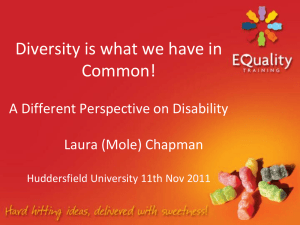
![You can the presentation here [Powerpoint, 1.01MB]](http://s2.studylib.net/store/data/005417570_1-0810139cfc2485ebcaf952e0ae8bb49a-300x300.png)


